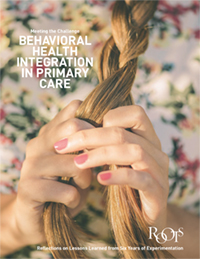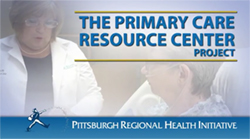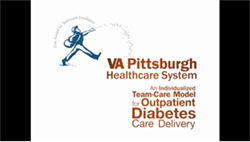SUCCESS STORIES
Twenty years ago, the Pittsburgh Regional Health Initiative (PRHI) presented a bold premise that has now been proven repeatedly. It posited that the same quality improvement techniques that had produced near-perfect performance in high risk, complex industries like aviation and nuclear power could be applied successfully in health care to reduce errors, improve reliability, and create efficiencies. We now know that techniques like Lean and PRHI’s own Perfecting Patient CareSM (PPC) methodology can reduce infections, improve patient flow, reduce laboratory errors, enhance the management of chronic diseases, and more. Here are just a few of PRHI's success stories.
Behavioral and Physical Health Integration
PRHI engaged in a series of implementation and dissemination experiments aimed at upending and reintegrating the worlds of behavioral health and physical health into a redesigned primary care setting— starting with Integrating Treatment in Primary Care (ITPC) from 2009-2010, then expanding to Partners in Integrated Care (PIC) from 2010-2013, and then to Care of Mental, Physical and Substance Use Syndromes (COMPASS) from 2012-2015. Using well-tested methods for identifying and treating common behavioral health problems, these real-world implementation experiments provided insight into the training needs, payment approaches, practice redesign, and patient engagement strategies needed to successfully implement and sustain these methods in primary care settings across the U.S. PRHI's work in this area is chronicled in our ROOTS publication: "Meeting the Challenge - Behavioral Health Integration In Primary Care."

Integrating Treatment in Primary Care (ITPC)
ITPC ambitiously aimed to pilot a three-pronged approach to behavioral integration at three community health centers in small, rural, or post-industrial towns in southwestern Pennsylvania. The approach entailed combining: 1) SBIRT to screen and provide brief intervention for risky substance use, 2) IMPACT to provide treat-to-target for depression, and 3) the Wagner Chronic Care Model to combine both IMPACT and SBIRT while addressing co-occurring chronic physical conditions. ITPC focused on adult patients with common chronic physical conditions – ischemic heart disease, heart failure, asthma, diabetes, or chronic obstructive pulmonary disease (COPD)– plus depression, unhealthy substance use, or both. At the conclusion of this pilot project, 32% of patients reached depression remission. ITPC was funded by the Jewish Healthcare Foundation, The Fine Foundation, and the Staunton Farm Foundation. Implementation assistance was provided by the AIMS Center at the University of Washington.
Partners in Integrated Care (PIC)
Around the same time that the ITPC project was winding down, the Agency for Healthcare Research and Quality (AHRQ) issued a request for applications that provided an opportunity to further disseminate IMPACT and SBIRT in primary care settings. PRHI, together with four partners, received $3.4 million in funding to spread this model in primary care practices across three states, and to lay the groundwork for further dissemination nationally. The joint project – named Partners in Integrated Care (PIC) – brought together the complementary experiences, resources, and expertise of several partners.
Implementation Partners were the Institute for Clinical Systems Improvement (Minnesota), Wisconsin Initiative to Promote Healthy Lifestyles, and the Wisconsin Collaborative for Healthcare Quality. Dissemination Partners were Massachusetts Health Quality Partners, Massachusetts SBIRT Training and Technical Assistance, and the Network for Regional Healthcare Improvement.
Over the course of the three-year project, the combination of SBIRT and IMPACT in PIC was implemented in 57 primary care offices across four states (initially in Pennsylvania, Minnesota, Wisconsin, and later in Massachusetts). The primary care teams received training followed by practice coaching on workflows, skill development, and quality improvement. Moreover, the partners offered regional and multi-state collaborative networking opportunities for the medical groups to learn from each other.
| Partners in Integrated Care (PIC) RESULTS | |||
| 1,602 Patients received brief interventions for substance misuse |
4,552 Patients started depression care management |
33% Percentage of those past-28 day binge drinking decline |
38% Percentage of eligible patients who achieved depression remission |
Care of Mental, Physical, and Substance Use Syndromes (COMPASS)
Equipped with lessons learned from PIC on how to design a dissemination project across multiple organizations and states, the Institute for Clinical Systems Improvement and seven other partners, including PRHI, received an $18 million Health Care Innovation Award from the Center for Medicare & Medicaid Innovation to implement and evaluate a collaborative care management model for adult primary care patients with sub-optimally managed depression, plus diabetes and/or cardiovascular disease. Eighteen medical groups with 172 sites, including 28 sites in Pennsylvania, participated.
| Care of Mental, Physical, and Substance Use Syndromes (COMPASS) RESULTS - PRHI-led Pennsylvania Portion | ||||
| 760 Patients enrolled in COMPASS |
74% Percentage of those enrolled who significantly improved their depression |
29% Percentage of those enrolled who achieved depression remission |
58% Percentage of those enrolled with an A1C less than 8 (compared to 41% at baseline) |
60% Percentage of those enrolled who had blood pressure below 140/90 (if the initial reading was elevated) |
Chronic Disease Readmission Reduction
PRHI worked with regional hospitals to establish Primary Care Resource Centers (PCRC) to reduce chronic disease readmissions. The PCRCs collectively achieved a 25% reduction in 30-day hospital readmissions, and reduced the 90-day total costs of care by more than $1,000 per Medicare patient. While the grant phase of the project has ended, five of the six participating community hospitals have decided to self-fund their PCRCs. The multi-phase project is outlined below.
By the numbers:
| 51 Nurses, Phamacists,and AAs Trained in PCRCs |
8,496 Unique Patients Enrolled |
13,550 Admissions Seen by PCRC Teams |
| 32,543 Inpatient Visits by PCRC Teams |
32,709 Follow-Up Telephone Calls |
2,313 Home Visits by PCRC Teams |
| 1,108 Outpatient Visits in the PCRCs |
14.2% Fewer Readmissions, First vs. Last Quarter |
$1,508 Post-acute Savings per Discharge Over 90 Days |
Phase I (demonstration project)
With data from the Pennsylvania Health Care Cost Containment Council, PRHI identified COPD as a high-impact readmission reduction opportunity and collaborated with a team at one local hospital on a demonstration project. Any patient admitted to the hospital with a primary or secondary diagnosis of COPD could participate in the project. The team included pulmonary and family practice primary care physicians, representatives from nursing, quality, pharmacy, respiratory, physical and occupational therapies, dietary, care management, home care, emergency, nursing education, and IT.
Using PRHI's Perfecting Patient CareSM Lean methodology for health care, the inpatient team observed the current condition and concluded:
- readmitted COPD patients were not taking their inhaler medications
- there was ineffective and inconsistent inhaler training for the patients
- a critical opportunity for reducing readmissions occurred shortly after a hospital discharge
A new protocol was instituted:
- inhaler training and smoking cessation education was now the responsibility of the respiratory department, instead of nursing
- the inpatient-outpatient team then made improvements to the system of patient care that bridged both hospital and community; a care manager was hired and met with patients while they were hospitalized, and followed up with home visits at which inhaler training was reinforced, education on patient care plans reviewed, and other needs assessed
Additionally, the inpatient-outpatient team corrected the following processes for patients with COPD:
- methods for identifying readmissions and determining how inpatient care should change
- guidelines for care of patients during their stay and post-discharge, as well as mechanisms for monitoring deviations
- methods for training physicians and staff on guidelines and processes
- mechanisms for preparing a patient for discharge
One year after the new protocol was rolled out, this hospital saw a 44% reduction (payer net savings of $217,000) in patients admitted for COPD exacerbation and readmitted within 30 days for COPD or pneumonia.
Phase II - Primary Care Resource Center (prototype)
About one in five patients at local community hospitals were being readmitted to the hospital within 30 days after discharge. When PRHI looked at the numbers for some of the diseases with the highest 30-day readmission rates – chronic obstructive pulmonary disease, acute myocardial infarction, and heart failure – the data were astounding.
Building on the success of the demonstration project, PRHI, with a pilot grant from Highmark, collaborated with a 210-bed, full-service community hospital to open the first Primary Care Resource Center (PCRC) - a dedicated space in the hospital for centralized, coordinated care for patients with COPD, CHF, or CAD. With PRHI's Perfecting Patient CareSM Lean methodology providing the foundation, the Monongahela Valley Hospital PCRC opened July 2012. They implemented the best practices from Phase I, and supplemented their three nurse care managers with a clinical pharmacist dedicated to the team. The hospital covered the cost of the pharmacist. The idea was to introduce hospitalized patients to a nurse and a pharmacist who would follow up with them after they left the hospital – not just by phone, but in person in the home if needed. The contact would continue for at least 30 days. Monongahela Valley Hospital developed care paths, physician outreach strategies, and data collection tools that led to a 45% reduction in COPD readmissions, and provided a blueprint for Phase III.
Phase III - Primary Care Resource Centers
The Centers for Medicare and Medicaid Services’ Innovation Center provided a testing ground for new, disruptive service delivery and payment models. Through an ultra-competitive process, organizations were chosen to translate their concepts to the front lines of care in the name of better population health and lower costs. The initial data from Phase II was strong enough to persuade the Centers for Medicaid and Medicare Services Innovation Center to award the Pittsburgh Regional Health Initiative $10.4 million in 2013 to expand the concept to six community hospitals in the region for two years:
- Butler Memorial Hospital
- Conemaugh Memorial Medical Center
- Indiana Regional Medical Center
- Sharon Regional Medical Center
- Wheeling Hospital
- Uniontown Hospital
Everyone taking part in the PCRC project received PRHI's Perfecting Patient CareSM Lean training, as well as advanced disease management expertise to offer complex patients one-stop, coordinated outpatient care. PRHI applied design thinking to make care pathways and procedures sustainable for participating hospitals, and helped the staffs examine their own work flow and craft more efficient, durable procedures.
At each location, the hospital tweaked the format to address its patients’ needs – creating ideas for the other hospitals to add. The PCRC project’s innovations are numerous:
- better patient education
- to careful discharge planning
- to better care transitions
- embedding a pharmacist on the care team
- by leveraging community resources to support patients post-discharge
- preparing the teams with ongoing training in quality improvement, advanced disease management, best practices in discharge planning, patient motivational interviewing, as well as information sessions on palliative and end-of-life care
Diabetes Clinic
An endocrinologist at the VA Pittsburgh Healthcare System found it nearly impossible to provide comprehensive care in a single patient visit. He worked with the Pittsburgh Regional Health Initiative and its "Physican Champions" program to implement a new "team" approach to diabetes care. PRHI coached the physician and staff in Perfecting Patient CareSM principles which they applied to the new approach that combined intensity, volume, and personalized care. Along with the physician, the team consisted of a nurse educator, a pharmacist, a nutritionist, and a nurse practictioner. The patient spends roughly 15 minutes at each "station." The physician "floats" among the stations, observing and troubleshooting as necessary. The providers noted that the methods taught by PRHI were directly responsible for increasing the flow of patients during clinic hours. This project was one of the first recipients of the Fine Awards for Teamwork Excellence in Health Care.
Hospital-Acquired Infections
CLABS (Regional)
In 2001, the Pittsburgh Regional Health Initiative (under the auspices of the CDC with a grant from AHRQ) convened infection control practitioners and infectious disease physicians from across the region, and from across competing healthcare systems, to reduce central line-associated bloodstream infections in the region's intensive care units. This consortium learned the Perfecting Patient CareSM (PPC) methodology which was supplemented with on-site coaching from PRHI staff. PPC prevents infections by improving the design and flow of work and eliminating potential errors. Staff received training about infection control measures, prevention checklists, hospital unit feedback on infection rates, and adherence to appropriate preventive practices. At the conclusion of the grant, the 29 participating hospitals showed a 63% decline in the central line infection rate.
CLABS (Local)
In 2004, a local medical department chair took on the bold task of eliminating central line infections within 90 days on the two intensive care units he supervised. He had become frustrated with the pace of change in medicine. He wanted to test whether or not using PRHI's Perfecting Patient CareSM methodology could accelerate improvements. He and his team established the current condition by conducting a chart review of more than 1,700 patients. Then, he and PRHI staff observed the actual work in detail, over time. This revealed variations in practice among doctors and nurses. They used real-time data from the lab and acted on it immediately with every symptomatic patient. They would solve problems one by one, as close to the time and place of the occurrence as possible. Finally, all nurses and doctors were provided continuous learning, including the use of central line simulators. The following countermeasures were adopted within 90 days: 1) remove and replace femoral lines within 12 hours; 2) replace faulty catheters rather than trying to fix them; 3) replace central lines that patients already have when they transfer in; and 4) use the subclavian area for central line placement when possible. Additional protocols were developed and implemented. At the end of the three-year study period, both intensive care units sustained a greater than 95% reduction in central line infections, and reduced deaths to zero.
Regional Extension and Assistance Center for HIT (REACH)
As a Regional Extension Center, the Pittsburgh Regional Health Initiative (PRHI) assisted western Pennsylvania primary care providers in adopting, implementing, and achieving Meaningful Use of their electronic health record (EHR) systems. At the project's conclusion, 860 providers were assisted across 340 sites; 99% of those providers were using EHRs; and 90% have attained Meaningful Use.
Safety Net Medical Home Initiative
The Pittsburgh Regional Health Initiative (PRHI) was one of five national Regional Coordinating Centers for the Safety Net Medical Home Initiative (SNMHI). In 2009, PRHI received a four-year grant from the Commonwealth Fund to support the training and on-site coaching of Federally Qualified Health Centers (FQHCs) and FQHC-lookalikes in their transition to the Patient-Centered Medical Home (PCMH) model. Using PRHI's Perfecting Patient CareSM methodology, PRHI staff collaborated with ten local community-based health centers in this transition. The practices, serving many at-risk patients, worked with PRHI to implement electronic health records, increase patient access, and reach out to those missing appointments or lacking connections to the health system entirely.

